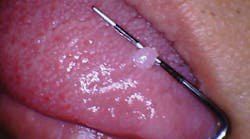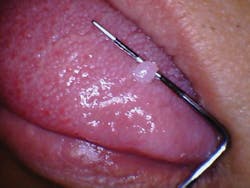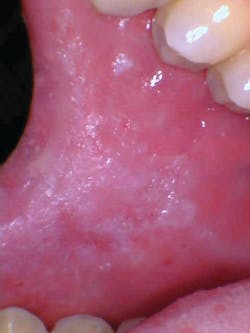Getting patients to stop chronic habits such as cheek and/or lip chewing helps minimize trauma to the oral tissues.
The fibroma is the most common tumor of the oral tissues and is classified as a reactive hyperplasia usually caused by chronic local irritation. Although the irritation fibroma typically disappears after the frictional cause is removed, some fibromas/fibrous proliferations (growth of the tissues) are not associated with chronic oral trauma, such as the giant cell fibroma or fibromatosis.
The fibroma is found on the buccal mucosa, lips, tongue, or labial mucosa as a single entity. Often, patients are aware that they have traumatized the area multiple times. They may even admit to constant or chronic chewing of the fibrous growth and call it to the attention of the dental professional. The patient’s chronic behavior often becomes a standard daily practice and may cause the fibroma to continue to increase in size.
A differential diagnosis may include the following:
• Neurofibroma—slow-growing mass usually found on the tongue or buccal mucosa, but other locations as well
• Neurilemmoma—occurs most frequently on the tongue and is most often accompanied by some pain
• Lipoma—usually has a yellow hue due to lipid content
• Peripheral ossifying fibroma—occurs on the gingiva
• Fibrosarcoma—very rare, but all soft-tissue tumors must be ruled out. Fibrosarcomas are painless, but gradually enlarge.
Surgical removal of the growth is needed, and the dental professional should consider evaluating any chronic habits that the patient may exhibit. Chronic cheek chewing, lip chewing, or irritation, such as sharp edges of teeth, may lead to other fibromas. Fibromas are often easily determined by evaluating patients’ habits as patients are usually aware of their own behavior. However, the only true way to know the histology of the growth is to surgically remove it and view the tissue microscopically.
The following are some clinical suggestions for assisting patients in discontinuing habits that may contribute to an irritation fibroma.
Assisting patients who chronically traumatize oral tissues
First, show the patient the area of concern. Determine if he or she is aware of the trauma to the oral tissue. Morsus in Latin means bite. Morsicatio buccarum (chronic chewing of buccal mucosa), morsicatio labiorum (chronic chewing of lip tissue), or morsicatio linguarum (chronic chewing of the tongue) are used to describe specific oral areas.1 Give the patient a hand mirror and use the dental lighting to observe the area together. Intraoral images are beneficial as the images project well on the screen.
Try to determine whether the patient is chewing on the area at night, during the day, or at other specific times. Professionally produced night guards may be helpful for patients who have this habit at night. Patients may often exhibit evidence of bruxism as noted by changes in the tooth surface. Some shields can also be fabricated and worn daily. Specific protocol is key for children with bruxism or chewing habits.
If the patient is new, determine how long ago he or she noticed the habit. If the tissue is being observed in a patient of record, review the history to determine if any notation was listed in prior visits. How long has the issue been documented? This may be especially relevant since chronic habits can take a long time to change.
If situational stress is determined to be the problem, suggest stress-reduction techniques. Forming new coping strategies is crucial in changing a chronic, negative habit and modifying the way we react to stressors. Some helpful techniques may be exercise, prayer, meditation, or other techniques such as biofeedback. Biofeedback will teach the patient to use breathing and focus to reduce stress. Experts in biofeedback are often found in schools of dentistry and medicine, and are widely available in the public domain.
Most people with stress-related conditions are not aware of the problem, and they will tell you that they are no more stressed than anyone else. We all handle stress in different ways, and some coping techniques are better than others. Ultimately, success depends upon the individual. The good news is, stress reduction can be learned, and coping skills can be developed.
In certain situations, the patient may have taken antianxiety medications and has since discontinued their use, which led to poor health habits. Suggesting that such patients contact their physician or see a counselor may be appropriate, depending on the person and the clinical signs. In today’s society, many people are overwhelmed with everyday stress, and many dental offices report an increase in the number of people who are diagnosed with morsicatio buccarum, morsicatio linguarum, and morsicatio labiorum,1 as well as both day and night bruxism.
Use intraoral photography to document areas of concern and use those images for future comparison at maintenance visits.
If the patient uses tobacco and/or alcohol, there is further concern related to future changes in the tissue and oral cancer. If the patient has not had an oral cancer screening, perform one at each visit or suggest a biopsy if there is any indication that the area of concern could possibly be malignant. If changes occur or the habit continues, careful evaluation, referral, or future biopsy is needed. Biopsy should always be considered when any oral growth continues after the original friction element is removed.
Remind the patient that any irritation or inflammation in the body is detrimental to health. Pathogens are able to enter the body due to compromised tissues, and chronic inflammation places people at risk for other health-related diseases.
Develop a few techniques that will make the patient aware of the habit:
• Tie a ribbon, rubber band, or string around the wrist. This is always helpful in behavior modification and can be used as a reminder to the patient to check his or her own behavior.
• Place strategically located stickers in the home and workplace to remind the patient to check his or her progress.
• Many individuals also have a smart watch that can be used as a reminder to check behaviors related to chronic chewing by sending reminders in the form of messages or periodic beeps.
Finally, have the patient visualize the word “No” circled with an X through it. This step will help the patient eliminate the habit through visualization. Evoking awareness in the patient and stating the importance of the need to diminish the habit are necessary for success.
Reference
1. Burkhart NW. Morsicatio buccarum, labiorum, and linguarum. RDH Magazine. December 1, 2011. https://www.rdhmag.com/career-profession/personal-wellness/article/16408641/morsicatio-buccarum-labiorum-and-linguarum
Additional resource
• DeLong L, Burkhart NW. General and Oral Pathology for the Dental Hygienist. 3rd ed. Baltimore, MD: Wolters Kluwer; 2019.










